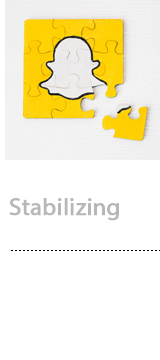
Snap is no longer losing users.
For the third consecutive quarter, Snap managed to stave user decline. Its Q4 daily active users clocked in at 186 million, which was flat sequentially but a slight year-over-year dip from 187 million.
And advertisers are still spending on the platform. Q4 revenue grew 36% to $390 million, while its 2018 revenue soared 43% to $1.2 billion. Average revenue per user increased 37% year over year to $2.09.
“We are substantially closer to achieving profitability,” CEO Evan Spiegel said Tuesday during the company’s Q4 and 2018 earnings call.
Sales reorg
While advertisers still love Snap’s creative canvas and young audience, the platform sees greater opportunity to work more closely with brand advertisers.
To do so, Snap reorganized its sales team last week into a vertical model by industry. The new structure will ensure that as Snap matures, its sales org is “set up with a durable structure for the future,” said chief business officer Jeremi Gorman.
“It makes for a more consultative and successful organization and enhances our relationship with advertisers,” she said.
Snap also sees an opportunity to grow brand engagements through premium content on Discover. While the platform didn’t break out the percentage of its revenue that comes from premium content, its six-second nonskippable commercial ad unit is resonating with marketers – especially creatives, Spiegel said.
“People are investing a lot in the quality and taking the format seriously,” he said. “We’re seeing the early stages of advanced narrative engagement in a format that works for customers.”
While 30% more users are watching professionally produced content in Discovery every day, there’s still room to grow. To draw more users to premium content, Snap will invest in making the Discover section more personalized for users and better merchandise content through its nascent ecommerce business.
“We’re most focused on Discover and improving the depth and engagement there,” Spiegel said. “We see a lot of demand for user generated and premium content, and we’re working to surface both in ways that resonate with users.”
But Snap hasn’t forgotten about its direct response advertisers. Improvements to its self-serve platform allow performance marketers to bid against specific KPIs such as purchases, app installs or sign-ups. Total impressions on the platform swelled 179% year over year and 30% sequentially, and ad prices rose 3% sequentially.
“We made a deliberate pivot to work with direct response advertisers last year,” Gorman said. “We’re seeing a lot of success in that.”
Growing pains
Snap, which suffered an exodus of its C-suite last year, including chief strategy officer Imran Kahn and chief content officer Nick Bell, still has gaping holes in its executive roster.
Spiegel said hiring a chief financial officer and chief marketing officer are a priority but Snap will “take our time with the search and get it right.”
Investors are also getting impatient with Snap’s ability to improve its service on Android, which is limiting its capacity to grow in markets outside the US. The platform reduced the time it takes to open a Snap by 20% in Q4, but it’s still not enough to catch on with users.
“Two billion people are on Android and don’t have Snap,” Spiegel said. “If we can take a few percent market share there, it would make a real difference to our user base.”
This post was syndicated from Ad Exchanger.


More Stories
5 Ways Brands Can Weather a Tariff Storm as Consumer Spending Shifts Toward Value
Creativity shines
Hilton Uses Social Listening to Showcase ‘Superior’ Stays